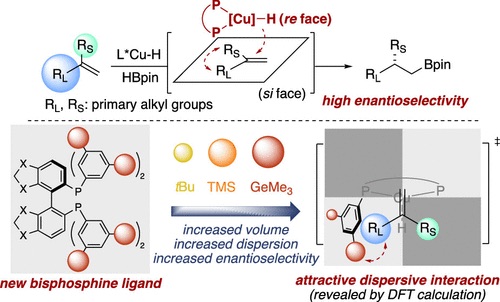Application of Trimethylgermanyl-Substituted Bisphosphine Ligands with Enhanced Dispersion Interactions to Copper-Catalyzed Hydroboration of Disubstituted Alkenes
J. Am. Chem. Soc., 2020, 142 (18213-18222)
View on publisher site
Abstract
We report the incorporation of large substituents based on heavy main-group elements that are atypical in ligand architectures to enhance dispersion interactions and, thereby, enhance enantioselectivity. Specifically, we prepared the chiral biaryl bisphosphine ligand (TMG-SYNPHOS) containing 3,5-bis(trimethylgermanyl)phenyl groups on phosphorus and applied this ligand to the challenging problem of enantioselective hydrofunctionalization reactions of 1,1-disubtituted alkenes. Indeed, TMG-SYNPHOS forms a copper complex that catalyzes hydroboration of 1,1-disubtituted alkenes with high levels of enantioselectivity, even when the two substituents are both primary alkyl groups. In addition, copper catalysts bearing ligands possessing germanyl groups were much more active for hydroboration than one derived from DTBM-SEGPHOS, a ligand containing 3,5-di-tert-butyl groups and widely used for copper-catalyzed hydrofunctionalization. This observation led to the identification of DTMGM-SEGPHOS, a bisphosphine ligand bearing 3,5-bis(trimethylgermanyl)-4-methoxyphenyl groups as the substituents on the phosphorus, as a new ligand that forms a highly active catalyst for hydroboration of unactivated 1,2-disubstituted alkenes, a class of substrates that has not readily undergone copper-catalyzed hydroboration previously. Computational studies revealed that the enantioselectivity and catalytic efficiency of the germanyl-substituted ligands is higher than that of the silyl and tert-butyl-substituted analogues because of attractive dispersion interactions between the bulky trimethylgermanyl groups on the ancillary ligand and the alkene substrate and that Pauli repulsive interactions tended to decrease enantioselectivity.
Read on publisher's site